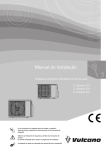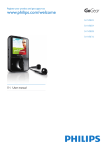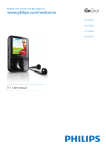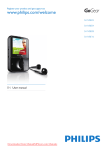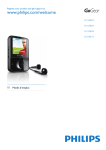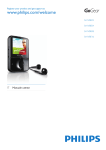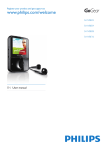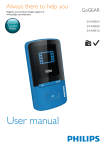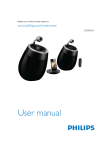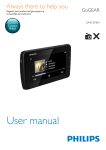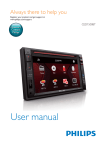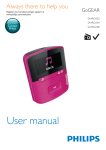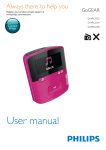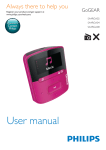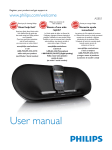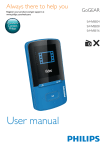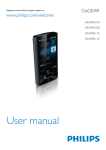Download SA2ARA English user manual
Transcript
Register your product and get support at www.philips.com/welcome SA1VBE04 EN User manual 1 Important safety information General maintenance Recycling the product and the built-in battery 2 2 5 2 Your new VIBE What’s in the box 6 6 3 Getting started 7 Overview of the controls and connections Limit the volume Overview of the main menu Connect and charge Software loaded on the VIBE Files loaded on the VIBE 7 7 7 8 9 9 4 Update VIBE 10 10 5 Turn VIBE on and off 11 11 11 Manually verify / update the firmware Automatic shut-down Lock the keys 6 Philips Songbird Build a media library Browse your media library Organize and manage your Songbird library Playlists Change the look of the Songbird library Format VIBE (erase all music and data) Repair VIBE (restore factory settings) 7 Music Listen to music Navigate inside a music track Play music from a filtered selection Find your music 8 Audiobooks Add audiobooks to VIBE Audiobook controls 12 12 13 13 14 15 15 15 16 16 16 16 16 18 18 18 Select audiobook by book title Add a bookmark in an audiobook Find a bookmark in an audiobook Delete a bookmark in an audiobook 18 19 19 19 9 Video 20 20 20 20 20 10 Pictures 21 21 21 21 21 21 11 Radio 22 22 22 22 22 12 Recordings 23 23 23 23 23 24 13 Use the VIBE to carry data files 25 14 Settings 26 15 Technical data 28 28 16 Glossary 29 Play videos Navigate inside a video Delete the currently playing video Delete one or more videos Add pictures to VIBE View pictures Start a slideshow Delete the currently displayed picture Delete one or more pictures Listen to FM radio Manually tune a radio station Auto-tune radio station presets Play a preset radio station Record audio/voices Listen to recordings Upload your recordings to a computer Delete the currently playing video Delete one or more recordings System requirements Need help? Please visit www.philips.com/welcome where you can access a full set of supporting materials such as the user manual, the latest software updates, and answers to frequently asked questions. EN 1 E ng lis h Contents 1 Important safety information Replacement parts/accessories: Visit www.philips.com/support to order replacement parts/accessories. Hearing Safety General maintenance The translation of this document is for reference only. In the event of any inconsistency between the English version and the translated version, the English version shall prevail. Caution •• To avoid damage or malfunction: •• Do not expose the product to excessive heat caused by heating equipment or direct sunlight. •• Do not drop the product or allow objects to fall on your player. •• Do not allow the product to be submerged in water. Do not expose headphone socket or battery compartment to water, as water entering the set may cause major damage. •• Active mobile phones in the vicinity may cause interference. •• Back up your files. Ensure that you retain the original files you have downloaded to your device. Philips is not responsible for any loss of data if the product becomes damaged or not readable / legible. •• Manage (transfer, delete, etc.) your music files only with the supplied music software to avoid problems. •• Do not use any cleaning agents containing alcohol, ammonia, benzene, or abrasives as these may harm the product. About operating and storage temperatures • Operate in a place where temperature is always between 0 and 35ºC (32 to 95ºF) • Store in a place where temperature is always between -20 and 45ºC (-4 to 113ºF). • Battery life may be shortened in low temperature conditions. 2 EN Listen at a moderate volume: Using headphones at a high volume can impair your hearing. This product can produce sounds in decibel ranges that may cause hearing loss for a normal person, even for exposure less than a minute. The higher decibel ranges are offered for those that may have already experienced some hearing loss. Sound can be deceiving. Over time your hearing ‘comfort level’ adapts to higher volumes of sound. So after prolonged listening, what sounds ‘normal’ can actually be loud and harmful to your hearing. To guard against this, set your volume to a safe level before your hearing adapts and leave it there. To establish a safe volume level: Set your volume control at a low setting. Slowly increase the sound until you can hear it comfortably and clearly, without distortion. Listen for reasonable periods of time: Prolonged exposure to sound, even at normally ‘safe’ levels, can also cause hearing loss. Be sure to use your equipment reasonably and take appropriate breaks. Be sure to observe the following guidelines when using your headphones. Listen at reasonable volumes for reasonable periods of time. Be careful not to adjust the volume as your hearing adapts. Do not turn up the volume so high that you can’t hear what’s around you. You should use caution or temporarily discontinue use in potentially hazardous situations. Do not use headphones while operating a motorized vehicle, cycling, skateboarding, etc.; it 0RGLÀFDWLRQV &KDQJHVRUPRGLILFDWLRQVWRWKLVXQLWQRW H[SUHVVO\DSSURYHGE\WKHSDUW\UHVSRQVLEOHIRU FRPSOLDQFHFRXOGYRLGWKHXVHU·VDXWKRULW\WR RSHUDWHWKHHTXLSPHQW Cop\ULJKWLQfRUPDWLRQ $OORWKHUErDQGVDQGSURGXFWQDPHVDUH trDGHPDrNVRIWKHLUUHVSHFWLvHFRPSDQLHVRU RrJDQL]DWLRQV 8QDXWKRrL]HGGXSOLFDWLRQRIDQ\UHFRUGLQJV ZKHWKHUGRZQORDGHGIURPWKH,QWHrQHWRU PDGHIURPDXGLR&'VLVDYLRODWLRQRIFRSyrLJKW OaZVDQGLQWHrQDWLRQDOWUHDWLHV 7KHPDNLQJRIXQDXWKRrL]HGFRSLHVRIFRSySURWHFWHGPDWHrLDO,LQFOXGLQJFRPSXWHU SURJrDPV,ÀOHV,EURDGFDVWVDQGVRXQG UHFRUGLQJV, ma\EHDQLQIrLQJHPHQWRI FRSyrLJKWVDQGFRQVWLWXWHDFrLPLQDORIfHQVe 7KLVHTXLSPHQWVKRXOGQRWEHXVHGfRUVXFK SXrSRVHV 7KH :LQGRZV 0HGLD DQG WKH :LQGRZV ORJR are UHJLVWHUHGWrDGHPDrNVRI0LFURVRIW&RrSRrDWLRQ LQWKH8QLWHG6WDWHVDQGRURWKHUFRXQWrLHV %HrHVSRQVLEOH5HVSHFWFRp\ULJKWV 3KLOLSVUHVSHFWVWKHLQWHOOHFWXDOSURSHrW\RI RWKHrV,DQGwHDVNRXUXVHrVWRGRWKHVDPe 0XOWLPHGLDFRQWHQWRQWKHLQWHrQHWPa\Kave EHHQFUHDWHGDQGRUGLVWrLEXWHGZLWKRXWWKH RrLJLQDOFRSyrLJKWRZQHU’VDXWKRrL]DWLRQ &RS\LQJRUGLVWrLEXWLQJXQDXWKRrL]HGFRQWHQW ma\YLRODWHFRSyrLJKWOaZVLQYDrLRXVFRXQWrLHV LQFOXGLQJyRXrV &RPSOLDQFHZLWKFRSyrLJKWOaZVUHPDLQVyRXU UHVSRQVLELOLWy 7KHUHFRUGLQJDQGWrDQVfHUWRWKHSRrtaEOH SOayHURIYLGHRVWUHDPVGRZQORDGHGWRyRXU FRPSXWHULVLQWHQGHGRQOy fRUXVHZLWKSXEOLF GRPDLQRUSURSHrO\OLFHQVHGFRQWHQWYRX ma\RQO\XVHVXFKFRQWHQWfRUyRXUSrLYDWe, non-commercial use and shall respect eventual copyright instructions provided by the copyright owner of the work. Such instruction may state that no further copies shall be made. Video streams may include copy protection technology that prohibits further copying. For such situations the recording function will not work and you will be notified with a message. Data logging Philips is committed to improving the quality of your product and enhancing the Philips user experience. To understand the usage profile of this device, this device logs some info / data to the non-volatile memory region of the device. These data are used to identify and detect any failures or problems you as a user may experience while using the device. The data stored, for example, will be the duration of playback in music mode, duration of playback in turner mode, how many times battery low was encountered, etc. The data stored do not reveal the content or media used on the device or the source of downloads. The data stored on the device are retrieved and used ONLY if the user returns the device to the Philips service center and ONLY to simplify error detection and prevention. The data stored shall be made available to user on user’s first request. Monkey’s Audio decoder a The Monkey’s Audio SDK and source code can be freely used to add APE format playback, encoding, or tagging support to any product, free or commercial. Use of the code for proprietary efforts that don’t support the official APE format require written consent of the author. b Monkey’s Audio source can be included in GPL and open-source software, although Monkey’s Audio itself will not be subjected to external licensing requirements or other viral source restrictions. EN 3 English may create a trDIÀFKD]DUGDQGLVLOOHJDOLQPDQy DUHDV c Code changes and improvements must be contributed back to the Monkey’s Audio project free from restrictions or royalties, unless exempted by express written consent of the author. d Any source code, ideas, or libraries used must be plainly acknowledged in the software using the code. e Although the software has been tested thoroughly, the author is in no way responsible for damages due to bugs or misuse. If you do not completely agree with all of the previous stipulations, you must cease using this source code and remove it from your storage device. FLAC decoder Copyright (C) 2000,2001,2002,2003,2004,2005, 2006,2007,2008,2009 Josh Coalson Redistribution and use in source and binary forms, with or without modification, are permitted provided that the following conditions are met: • Redistributions of source code must retain the above copyright notice, this list of conditions and the following disclaimer. • Redistributions in binary form must reproduce the above copyright notice, this list of conditions and the following disclaimer in the documentation and/ or other materials provided with the distribution. • Neither the name of the Xiph.org Foundation nor the names of its contributors may be used to endorse or promote products derived from this software without specific prior written permission. THIS SOFTWARE IS PROVIDED BY THE COPYRIGHT HOLDERS AND CONTRIBUTORS “AS IS” AND ANY EXPRESS OR IMPLIED WARRANTIES, INCLUDING, BUT NOT LIMITED TO, THE IMPLIED 4 EN WARRANTIES OF MERCHANTABILITY AND FITNESS FOR A PARTICULAR PURPOSE ARE DISCLAIMED. IN NO EVENT SHALL THE FOUNDATION OR CONTRIBUTORS BE LIABLE FOR ANY DIRECT, INDIRECT, INCIDENTAL, SPECIAL, EXEMPLARY, OR CONSEQUENTIAL DAMAGES (INCLUDING, BUT NOT LIMITED TO, PROCUREMENT OF SUBSTITUTE GOODS OR SERVICES; LOSS OF USE, DATA, OR PROFITS; OR BUSINESS INTERRUPTION) HOWEVER CAUSED AND ON ANY THEORY OF LIABILITY, WHETHER IN CONTRACT, STRICT LIABILITY, OR TORT (INCLUDING NEGLIGENCE OR OTHERWISE) ARISING IN ANY WAY OUT OF THE USE OF THIS SOFTWARE, EVEN IF ADVISED OF THE POSSIBILITY OF SUCH DAMAGE. XPAT XML Parser Copyright (c) 1998, 1999, 2000 Thai Open Source Software Center Ltd Permission is hereby granted, free of charge, to any person obtaining a copy of this software and associated documentation files (the “Software”), to deal in the Software without restriction, including without limitation the rights to use, copy, modify, merge, publish, distribute, sub-license, and/or sell copies of the Software, and to permit persons to whom the Software is furnished to do so, subject to the following conditions: The above copyright notice and this permission notice shall be included in all copies or substantial portions of the Software. THE SOFTWARE IS PROVIDED “AS IS”, WITHOUT WARRANTY OF ANY KIND, EXPRESS OR IMPLIED, INCLUDING BUT NOT LIMITED TO THE WARRANTIES OF MERCHANTABILITY, FITNESS FOR A PARTICULAR PURPOSE AND NONINFRINGEMENT. IN NO EVENT SHALL THE AUTHORS OR COPYRIGHT HOLDERS BE LIABLE FOR ANY CLAIM, DAMAGES OR OTHER LIABILITY, WHETHER IN AN Recycling the product and the built-in battery Your product is designed and manufactured with high quality materials and components, which can be recycled and reused. Never dispose of your product with other household waste. Please inform yourself about the local rules on the separate collection of electrical and electronic products and batteries. The correct disposal of these products helps prevent potentially negative consequences on the environment and human health. Please visit www.recycle.philips.com for additional information on a recycling center in your area. which can be determined by turning the equipment off and on, the user is encouraged to try to correct the interference by one or more of the following measures: • Relocate the receiving antenna. • Increase the separation between equipment and receiver. • Connect the equipment into an outlet on a circuit different from that to which the receiver is connected. • Consult the dealer or an experienced radio/TV technician for help. Notice for Canada This Class B digital apparatus complies with Canadian ICES-003. The set complies with the FCC-Rules, Part-15 and with 21 CFR 1040.10. Operation is subject to the following two conditions: • This device may not cause harmful interference, and • This device must accept any interference received, including interference that may cause undesired operation. Caution • Removal of the built-in battery invalidates the warranty and can destroy the product. Philips SA1VBE04 Notice for the USA This equipment has been tested and found to comply with the limits for a Class B digital device, pursuant to part 15 of the FCC Rules. These limits are designed to provide reasonable protection against harmful interference in a residential installation. This equipment generates, uses, and can radiate radio frequency energy and, if not installed and used in accordance with the instruction manual, may cause harmful interference to radio communications. However, there is no guarantee that interference will not occur in a particular installation. If this equipment does cause harmful interference to radio or television reception, EN 5 E ng lis h ACTION OF CONTRACT, TORT OR OTHERWISE, ARISING FROM, OUT OF OR IN CONNECTION WITH THE SOFTWARE OR THE USE OR OTHER DEALINGS IN THE SOFTWARE. 2 Your new VIBE VIBE allows you to • play music • watch videos • listen to FM radio • make recordings What’s in the box Check that you have received the following items: Player Earphones USB cable Quick start guide Philips GoGear audio player Quick start guide 6 EN Note • The images serve as reference only. Philips reserves the right to change color/design without notice. Overview of the controls and connections Limit the volume E ng lis h 3 Getting started Caution • Listening to loud sounds for longer than a moment can be harmful to the listener. You can set the volume level of VIBE to limit the maximum volume output. 1 2 3 From the main menu, select [Settings] > [Sound settings] > [Volume limit]. Press the volume controls the level. / to adjust Press to confirm. » When you set a volume limit, VIBE can no longer exceed the set volume, even if you press the button to increase the volume . To enable maximum volume again: 1 a b c d e f g h i j RESET / press: reset GoGear Vibe press: scroll up/down press and hold: scroll up/ down at high speed slide and hold: turn GoGear Vibe on/off slide: lock/unlock all buttons except VOL display VOL press: increase/decrease the volume press and hold: increase/ decrease fast OPTIONS view available options press: play/pause USB connection jack press: back one level press and hold: scroll back at high speed headphone jack 2 3 Select [Settings] > [Sound settings] > [Volume limit]. Set the volume limit to maximum. Press to confirm. Overview of the main menu Menu Mode Music To play digital audio tracks Video play videos Pictures view pictures FM radio listen to FM radio Recordings create or listen to recordings Folder view files in folders view Settings customize the settings of VIBE Now show the current play playing screen EN 7 Connect and charge Install Philips Songbird for the first time VIBE has a built-in battery that can be charged through the USB port of a computer (USB cable included). When you connect VIBE to the PC for the first time, a pop-up window appears: Note 1 2 •• When you connect VIBE to a computer, you are briefly prompted to select: •• [Charge & transfer] or [Charge & play]. •• VIBE automatically applies [Charge & transfer], if no new selection is made. Connect VIBE to a computer 1 2 3 Connect the USB plug of the supplied USB cable to a spare USB port on your computer. Connect the small USB plug of the USB cable to the small USB jack on VIBE. Turn on your computer. »» VIBE charges. Select Install Philips Songbird. Follow the on-screen instructions to complete the installation. Note •• The installation requires you to agree to the license terms. If the pop-up window is not displayed automatically: 1 2 3 4 Select My Computer (Windows XP / Windows 2000) / Computer (Windows Vista / Windows 7). Right click on the Philips GoGear VIBE icon. Select Install Philips Songbird (Setup.exe). Follow the on-screen instructions to complete the installation. Note •• The installation requires you to agree to the license terms. 8 EN Important! The Philips Songbird software installer is preloaded to VIBE. To free memory capacity for your media FRQWHQWRQ9,%(WKHLQVWDOOHUÀOHLV DXWRPDWLFDOO\GHOHWHGGXULQJWKHÀUVW installation process. If you want to install the software any time DIWHUWKHÀUVWLQVWDOODWLRQIROORZWKHVH instructions: 1 2 3 4 Connect VIBE to the computer. Ensure that the computer is connected to the Internet, and then open Windows Explorer. In Windows Explorer, right click on VIBE, and then select the option to install Philips Songbird. » The computer downloads the installer ÀOHIURPWKH,QWHUQHW Follow the on-screen instructions to complete the installation. Battery level indication The display indicates the approximate levels of the battery status as follows: 100% 75% 50% 25% 0% » $ÁDVKLQJEDWWHU\VFUHHQLQGLFDWHV that the battery is low. The player saves all settings and switches off within 60 seconds. Note Rechargeable batteries have a limited number of charge cycles. Battery life and number of charge cycles vary by use and settings. The charging animation stops and the icon is displayed when the charging process is completed. Tip You can conserve battery power and increase the play time of VIBE if you go to > [Display Settings] > [Screen off timer] and ensure that the shortest timer setting is selected. Software loaded on the VIBE VIBE comes with the following software: Philips Songbird (helps you update the ÀUPZDUHRI9,%(DQGWUDQVIHU\RXUPHGLD ÀOHV Files loaded on the VIBE 7KHIROORZLQJÀOHVDUHORDGHGRQ9,%( User Manual Safety and warranty information Worldwide warranty information EN 9 E n gl i s h Install the Philips Songbird software DJDLQDIWHUWKHÀUVWLQVWDOODWLRQ 4 Update VIBE VIBE is controlled by an internal program called ÀUPZDUH1HZHUYHUVLRQVRIWKHÀUPZDUHPD\ have been released after you have purchased VIBE. The software program called Philips Songbird FDQXVH\RXUFRPSXWHUWRFKHFNIRUÀUPZDUH updates that are available on the Internet. Install Philips Songbird on your computer (see chapter Install software) and follow the instructions to update (see chapter Manually YHULI\XSGDWHWKHÀUPZDUH). Note <RXUPXVLFÀOHVDUHQRWDIIHFWHGE\DÀUPZDUH update. Manually verify / update the ÀUPZDUH 1 2 3 4 5 6 10 Ensure that your computer is connected to the Internet. Connect VIBE to the computer (see section Connect and charge for instructions). On your computer, click Start > Programs > Philips > Philips Songbird to launch the Philips Songbird application. Click VIBE in the Player pane. Then, select Helps > Check for updates in the pop-up window. » Philips Songbird checks for updates DQGLQVWDOOVQHZÀUPZDUHIURPWKH Internet, if available. Follow the on-screen instructions to XSGDWHWKHÀUPZDUHRI9,%( Wait until the update is completed, then disconnect VIBE from the computer. » 9,%(UHVWDUWVDIWHUWKHÀUPZDUHLV updated and is ready for use again. EN 1 English 5 Turn VIBE on and off To toggle between modes on and off, slide and hold for approximately 2 seconds. Automatic shut-down VIBE has an automatic shut-down feature that can save battery power. After 10 minutes in idle mode (no music plays, no button is pressed), VIBE turns off. 1 Slide and hold for approximately 2 seconds to turn VIBE on again. Lock the keys VIBE has a lock switch to prevent accidental operation. 1 2 To lock the buttons when you play, move the slider to position . »» All buttons except the volume keys are locked and the display shows a lock icon. To unlock the buttons again, move the slider to the center position. EN 11 6 Philips Songbird VIBE comes with the Philips Songbird software. The Philips Songbird software helps you to: • purchase new media (music and videos) online • create a media library • manage your media library • play music and videos • sync your media with the VIBE When Philips Songbird is launched for the first time, choose from the following options to import media files into the Songbird media library: • Import an existing iTunes library. • Scan for media files in specific directories. (You can select to watch a folder, so that the files that are added or deleted there are automatically added or deleted in the Songbird media library.) Build a media library Use one or more of the following options to build a media library with Songbird: Rip a CD By default, the Philips Songbird software installs the following add-ons that are needed to rip a CD: • CD Rip Support • Gracenote Metadata Lookup Provider Set up the CD rip options 1 2 3 4 12 On the computer, launch the Songbird program. Select Tools > Options.... Select the CD Rip tab, and then choose your CD rip options. Click on OK to confirm. EN Import media files from a directory The following steps show how you can import media (music and video) files that are stored elsewhere on your computer or computer network: 1 2 3 On the computer, launch the Songbird program. On the Songbird toolbar, click File, then select Import Media.... Select your media (music and video) files, then click OK. »» The media files that you added are listed in the media library. Tip •• If you select a folder that contains music or video files, the software scans the folder and adds all the music or video files it contains to the media library (duplicate titles are ignored). Import media from iTunes 1 2 3 4 5 On the computer, launch the Songbird program. Select Tools > Options.... On the Songbird toolbar, select the Media Importer tab, then iTunes Import/ Export. Verify your library location and options. Select Import Library. »» The software imports the iTunes library into Songbird. 1 2 3 4 5 On the computer, launch the Songbird program. Select Tools > Options.... On the Songbird toolbar, select the Media Importer tab, then iTunes Import/Export. Verify your library location and options. Select Export Library. »» The software exports the library from Songbird to iTunes. Get content from online sources You can purchase content from online sources such as the following: • 7-digital Check the specifications of your VIBE to see what services are available to you. Browse your media library The Songbird media library is structured as follows: a b d Organize and manage your Songbird library English Export media to iTunes Let Songbird manage your media 1 2 3 4 5 On the computer, launch the Songbird program. Select Tools > Options…. On the Songbird toolbar, select the Manage Files tab. Check Allow Songbird to manage my files. Set the options on how you want to organize your media. Remove media files from the Songbird media library 1 2 In the Songbird library, right click on a media file, then select Remove. In the prompt window, click Remove to confirm that you want to remove the file. »» The selected file is removed from the library and from all playlists. (By default, the file is only “removed”, not “deleted”. The media file still exists in its original location on the computer or computer network.) Tip •• To select multiple files on the computer (PC), press and hold Ctrl. c •• To select multiple consecutive files, press and hold Shift. a Player Pane (this is where the VIBE is displayed) b Library Pane (this is where you find the contents of your library) c Service Pane (this is where you find additional information about contents, such as playlists) d Information Pane (this is were you find information about the selected options) EN 13 Delete media 7KLVLVKRZWRGHOHWHPHGLDÀOHVLQ:LQGRZV Explorer: 1 2 3 With VIBE connected to the computer, open Windows explorer. Locate the media folder in VIBE. 'HOHWHWKHPHGLDÀOHLQWKHVDPHZD\DV you would from any other location on the computer. Let Songbird watch a folder You can let Songbird monitor the contents of a folder, and add or remove the media from your library to match the folder contents. 1 2 3 4 Create a playlist 1 2 Select Tools > Options.... On the Songbird toolbar, select the Media Importer tab, and then Watch Folders. Select the folder that you want Songbird to watch for changes. » The selected folder is watched and Songbird matches the library content to the content of the folder. Choose from these options to fetch the artwork for your albums: On the computer, launch the Songbird program. On the Songbird toolbar, select Tools > Get Artwork. » If no titles are selected, Songbird fetches the artwork for all titles in the library. Right-Click on selected titles. » Songbird fetches the artwork for all selected titles. 14 By default, the Philips Songbird software installs the following add-ons that are needed to rip a CD: CD Rip Support Gracenote Metadata Lookup Provider On the computer, launch the Songbird program. Fetch album artwork 1 Playlists EN 3 On the computer, launch the Songbird program. Choose from these options to create a new playlist: On the Songbird toolbar, select File > New Playlist. Right-click on the left hand sidebar, and then choose New Playlist. Click the + symbol at the bottom of the left hand side Service Pane. » A new playlist appears in the Service Pane. Enter a name for the new playlist. Add titles to a playlist 1 2 3 On the computer, launch the Songbird program. Select one or more titles. Choose from these options to add the selected titles to a playlist: Drag and drop the selected titles to the playlist in the Service Pane. Right-click on the selection, and then select Add to Playlist > The_name_ of_your_playlist. » All selected titles are added to the playlist. 1 2 3 On the computer, launch the Songbird program. Select a playlist. Right-click on the title that you want to remove, and then Remove. » The selected title is removed from the playlist. Format VIBE (erase all music and data) E n gl i s h Remove titles from a playlist Philips Songbird has a Format feature that you FDQXVHWRIRUPDW9,%(DQGHUDVHDOO\RXUÀOHV from the internal memory. Caution • The following procedure erases all your files that are stored on VIBE. Change the look of the Songbird library 1 You can change the design and color scheme of the Songbird library. We call this “changing feathers”. New feathers are installed and managed like add-ons. 2 Find new feathers 1 2 On the computer, launch the Songbird program. On the Songbird toolbar, select View > Feathers > Get More Feathers…. » The software searches for new feathers. » Follow the on-line instructions to install the new feathers. 3 4 5 Install Philips Songbird on your computer (see chapter Install software), and then launch the program. In the Philips Songbird player pane, click on VIBE. In the library pane, click on the tab called Tools. In the tools pane, click on Format. Follow the on-screen instructions to complete the repair procedure. Repair VIBE (restore factory settings) Philips Songbird has a repair feature that you can use to restore VIBE to the factory settings. Before you proceed, back up your files that are stored on VIBE if possible. Caution 7KHIROORZLQJSURFHGXUHHUDVHVDOO\RXUÀOHV that are stored on VIBE, and restores the factory settings. 1 2 3 Install Philips Songbird on your computer (see chapter Install software), and then launch the program. In the Philips Songbird menu bar (at the top), click on the Tools pull-down menu and then select Repair My Philips Device. Follow the on-screen instructions to complete the repair procedure. EN 15 7 Music Find your music Listen to music 1 2 3 From the main menu, select the music mode. to enter Navigate the sub-menus to select the music track. Press to toggle between play and pause. • Press OPTIONS to see more music options. • Press to go back one level. • Press and hold to return to the main menu. Navigate inside a music track 1 While you listen to a music track, press / to quickly navigate forward / backwards inside the track. • Press OPTIONS to view more music options. Play music from a filtered selection 1 2 While you listen to music, press OPTIONS and then select [Play mode] > [Play music from…]. Select the selection filter (example: selection filter[… this album] plays only music from the currently playing album). »» VIBE plays only music from the filtered selection. From the main menu, select to enter music mode. VIBE offers the following menu options: [All songs] • Alphabetically listed tracks [Artists] • Alphabetically listed artists • Alphabetically listed albums • Tracks listed in album order [Albums] • Alphanumerically listed albums • Tracks listed in album order [Album art] • Alphanumerically listed album art [Playlists] • [Playlist-on-the-go] • Tracks listed in playlist order [Audiobooks]* • Books listed in alphanumerical order Note •• * You can purchase audiobooks at online stores such as audible.com. •• VIBE handles the audiobooks like music files. Delete the currently playing music track This is how to delete the currently playing music track: 1 2 3 16 EN While you listen to the music track, press OPTIONS. Select the option to delete the music track. Select [Yes] to confirm the deletion. Delete one or more music tracks 1 2 3 English Use the Philips Songbird software to sync your media files. Alternatively, you can delete music in Windows Explorer: Connect VIBE to the computer. In Windows Explorer, locate the music folder in VIBE. Delete the music as you normally would on the computer. Note •• Alternatively, you can select from the main menu and find your files in folder view. EN 17 8 Audiobooks VIBE supports books in audio format. The use of this feature requires that you download the AudibleManager from audible.com. With the AudibleManager you can manage the digital contents of your audiobooks. Visit audible.com and register. The onscreen instructions guide you through the AudibleManager software download process. Add audiobooks to VIBE • 1 2 3 4 Important: VIBE supports audiobook format or format . On your computer, launch AudibleManager. Follow the online instructions to download your audiobooks in format or format . Follow the AudibleManager on-screen instructions to activate VIBE for your audiobooks. Follow the AudibleManager on-screen instructions to transfer your audiobooks to VIBE. Note •• VIBE can only play audiobooks for which it is activated. Audiobook controls VIBE offers the following audiobook mode controls: Goal Play / pause Skip forward to beginning of new section / chapter Skip back to beginning of current section / chapter Fast skip forwards through audiobook Fast skip backwards through audiobook Access options menu Return to browsing menu Increase / decrease volume EN Press Press and hold Press and hold Press OPTIONS Press Press VOL Tip •• You can resume play after navigating away from audiobooks. Select audiobook by book title 1 2 3 18 Action Press Press From the main menu, select music mode. Press or , then Audiobooks. to enter to select Press or to select title, then play. • To exit, press . to 1 2 3 English Add a bookmark in an audiobook In audiobook play mode, press OPTIONS. Press or , then [Bookmarks]. to select Press or , then to select [Add bookmark]. »» The display shows a confirmation screen. • To exit, press . Find a bookmark in an audiobook 1 2 3 4 5 In audiobook play mode, press OPTIONS. Press or , then [Bookmarks]. to select Press or , then bookmark]. to select [Go to Press or the list. to select the bookmark in Press to go to the selected bookmark. • To exit, press . Delete a bookmark in an audiobook 1 2 3 4 5 In audiobook play mode, press OPTIONS. Press or , then [Bookmark [x]]. to select Press or , then bookmark]. to select [Delete Press or the list. to select the bookmark in Press to delete the selected bookmark. • To exit, press . EN 19 9 Video Delete one or more videos Play videos 1 2 3 From the main menu, select the video mode. to enter Navigate the sub-menus to select the video. Press to toggle between play and pause. • Press OPTIONS to see more video options. • Press to go back one level. • Press and hold to return to the main menu. Navigate inside a video 1 While you watch a video, press / to quickly navigate forward / backwards inside the video. • Press OPTIONS to view more video options. Delete the currently playing video This is how to delete the currently playing video: 1 2 3 20 While you watch the video, press OPTIONS. Select the option to delete the video. Select [Yes] to confirm the deletion. EN Use the Philips Songbird software to sync your media files. Alternatively, you can delete music in Windows Explorer: 1 2 3 Connect VIBE to the computer. In Windows Explorer, locate the video folder in VIBE. Delete the video as you normally would on the computer. Note •• Alternatively, you can select from the main menu and find your files in folder view. Delete the currently displayed picture Add pictures to VIBE 1 2 3 Connect VIBE to the computer. In Windows Explorer, create folders in VIBE. Use drag and drop actions to sort your pictures into the folders. 2 3 4 From the main menu, select the picture mode. 1 2 3 While you view the picture in full-screen mode, press OPTIONS. Select the option to delete the picture. Select [Yes] to confirm the deletion. Delete one or more pictures View pictures 1 This is how to delete the currently displayed picture: to enter Use a computer to delete pictures in Windows Explorer: Navigate the sub-menus to select the picture. 1 2 Press mode. 3 to view the picture in full-screen Press / to rotate the picture. • Press OPTIONS to see more picture options. • Press to go back one level. • Press and hold to return to the main menu. Connect VIBE to the computer. In Windows Explorer, locate the picture folder in VIBE. Delete the pictures as you normally would on the computer. Note •• Alternatively, you can select from the main menu and find your files in folder view. Start a slideshow 1 While you view a video in full-screen mode, press to start a slideshow. • Press OPTIONS to view more slideshow options. EN 21 English 10Pictures Play a preset radio station Listen to FM radio 1 2 1 From the main menu, select to enter radio mode. » The earphones cable acts as FM antenna. Tip • Radio play stops when you switch to another mode or when you turn off VIBE. 3 While in mode, select preset. to switch to the next preset. Press Press and hold to switch on/off the sound. To search for the next stronger signal, press and hold or for 2 seconds. • To return to the main menu, press and hold for 2 seconds. Note • To play preset radio stations, you first have to store radio stations under presets. Manually tune a radio station While in mode, you can manually tune to a radio station: 1 2 To search for the next stronger signal, press and hold / . To fine tune the frequency, briefly press / . Auto-tune radio station presets The auto-tune feature of VIBE helps you find radio stations and save them under the preset numbers. 1 2 While in mode with the earphones connected, select a preset. Press OPTIONS and then select [Auto tune]. • If prompted, select [Yes] to confirm. » The radio automatically tunes radio stations and saves the frequencies to presets. There are 20 presets available. • • 22 EN To stop auto tuning, press . To return to the main menu, press and hold for 2 seconds. E ng lis h 11 Radio 12 Recordings Record audio/voices This is how you can record audio/voices with the built-in microphone (see section Overview for location of built-in microphone): 1 2 3 From the main menu, select > [Start voice recording]. • Press to toggle between pause and record. Press to stop. Press to save the recording or press to cancel. » Recordings are saved on the player. (Filename format: VOICEXXX.MP3, where XXX is the recording number that is generated automatically.) Upload your recordings to a computer Use the Philips Songbird software to sync your media files. Alternatively, you can transfer recordings in Windows Explorer: 1 2 3 4 Connect VIBE to the computer. In Windows Explorer, open VIBE. Select the folder Recordings > Voice or FM radio*. Copy and paste the recordings to any location on the computer. Note • * FM radio recording feature is available with some versions only. Refer to the on-screen menu of VIBE to find out which features are available to you. Tip • You can find your recordings under [Recordings Library] > [Voice]. Listen to recordings Listen to voice/audio recordings: 1 2 3 4 From the main menu, select . Press OPTIONS and then select [Recordings Library] > [Voice]. Delete the currently playing video This is how to delete the currently playing recording: 1 2 3 While you listen to a recording, press OPTIONS. Select the option to delete the recording. Select [Yes] to confirm the deletion. Select a recording. Press to play your recording. EN 23 This is how to delete recordings in Windows Explorer: 1 2 3 Connect VIBE to the computer. In Windows Explorer, locate the folder Recordings > Voice or FM radio*. Delete the recordings as you normally would on the computer. Note • * FM radio recording feature is available with some versions only. Refer to the on-screen menu of VIBE to find out which features are available to you. 24 EN E ng lis h Delete one or more recordings 13 Use the VIBE to carry data files This is how you use VIBE to store and carry data files: 1 2 Connect VIBE to the computer (for instructions see section Connect and charge). On the computer in Windows Explorer,copy the data files and paste them to VIBE. Tip • Use the computer to transfer your data files back to the computer, or delete your data files from VIBE. EN 25 Englis h 14 Settings This is how you customize VIBE: From the main menu, select to enter settings mode. In the menu, navigate as follows: 1 2 Press / to select an option. Press the next level (when available). Press to return to the previous level. Press and hold to exit the menu. In the menu, the following options are available: Settings Play mode Options menu Play music from... Repeat Sound settings FullSound Equalizer Volume limit Sleep timer Display settings Off (default) Set sleep timer... Theme Backlight timer 26 EN Sub-options menu ...all songs ...this album ...this artist Repeat off Repeat 1 Repeat all (default) Off On* (default) Off (default) Rock Funk Hip hop Off (default) Set Black (default) Blue Red 15 sec. (default) 30 sec. 45 sec. Always on Jazz Classical Techno Custom Settings Options menu Date and time Slideshow settings Language • Czech • Greek • English (default) • Danish • German • Spanish • French • Italian PC connection preference Information Capacity Free space Firmware version Support site Legal Formate device Factory settings Restore factory settings? (Files are not affected.) Sub-options menu • • • • • • • • Hungarian Dutch Norwegian Polish Portuguese Portuguese (Brazilian) Russian Slovak • • • • • • • Finnish Swedish Turkish Simplified Chinese Traditional Chinese Japanese Korean • Yes • No *Equalizer deactivates when FullSound is selected. EN 27 Power Power supply: 290 mAh Li-ion polymer internal rechargeable battery Play time¹ - music: 24 hours - video: 4 hours Software Philips Songbird: to update firmware and transfer music Connectivity Headphone 3.5 mm USB 2.0 High speed Sound Channel separation: 45 dB Frequency Response: 80 - 18,000 Hz Output power: 2 x 3.0 mW Signal to noise ratio: > 84 dB Audio playback Supported formats: MP3: MP3 bit rates: 8 - 320 kps and VBR MP3 sample rates: 8, 11.025, 16, 22.050, 32, 44.1, 48 kHz WMA: WMA bit rates: 5 - 320 kbps WMA sample rates: 8, 11.025, 16, 22.050, 32, 44.1, 48 kHz WAV FLAC APE Video playback Supported formats: MJPEG (in .mp4) Picture display Supported formats: JPEG BMP Storage media Built-in memory capacity²: SA1VBE04 4GB NAND Flash Display Color LCD 128 x 128 pixels 28 EN Note • ¹ Rechargeable batteries have a limited number of charge cycles. Battery life and number of charge cycles vary by use and settings. • ² 1GB = 1 billion bytes; available storage capacity is less. Full memory capacity may not be available as some memory is reserved for the player. Storage capacity is based on 4 minutes per song and 128 kbps MP3 encoding. System requirements • • • • • • • • Windows® XP (SP3 or above) / Vista / 7 Pentium III 800 MHz processor or higher 512 MB RAM 500 MB hard disk space Internet connection Windows® Internet Explorer 6.0 or later CD-ROM drive USB port E ng lis h 15 Technical data 16 Glossary B Bit rate Bit rate is the number of bits that are conveyed or processed per unit of time. The bit rate is usually measured in some multiple of bits per second (kilobits per second: kbps). The term bit rate is a synonym for data transfer rate (or simply data rate). C Compression In audio terms, this is a process of temporarily or permanently reducing audio data for more efficient storage or transmission. A temporary reduction in file size is called ‘non-lossy’ compression, and no information is lost. A permanent reduction in file size (such as with MP3 files) is called ‘lossy’ compression, and involves discarding unnecessary information which is irretrievably lost. D Decibel (dB) A unit of measure used to express relative difference in power or intensity of sound. F FM (Frequency Modulation) In radio broadcasting: a method of modulation in which the frequency of the carrier voltage is varied with the frequency of the modulation voltage. Frequency Response Is the range of frequencies that a speaker reproduces, lowest frequency to the highest. While the optimal normal is 20-20,000 Hz (Hertz), the range of human hearing for individuals is often much more restricted. A good full-range speaker system however, reproduces as much of this range as possible to cover all variations. Individual drivers are limited to reproduce only that part of the spectrum for which they were made, so their response is limited, but still a necessary point to consider when designing a complete sound system. FullSound FullSound™ is an innovative technology designed by Philips. FullSound™ faithfully restores sonic details to compressed music, enhancing it to provide a full sound experience without any distortion. L LCD (Liquid Crystal Display) Probably the most common way to show visual information on non-computer electronic equipment. Lossless compression A system for reducing the number of data bits (density) in a musical signal without corrupting the original. M MP3 A file format with a sound data compression system. MP3 is the abbreviation of Motion Picture Experts Group 1 (or MPEG-1) Audio Layer 3. With the MP3 format, one CD-R or CD-RW can contain about 10 times more data than a regular CD. EN 29 MTP [Media Transfer Protocol] Media Transfer Protocol supports the transfer of music and video files to portable audio and video players. R Rip (ripping) Using a software program that “grabs” digital audio from a compact disc and transfers it to a computer hard drive. The integrity of the data is preserved, because the signal does not pass through the computer sound card, and need not be converted to an analog format. The digital-to-digital transfer creates a WAV file that can then be converted into an MP3 file. S SuperScroll SuperScroll™ is a navigation feature of the double-action search keys of the product. SuperScroll™ allows easy speed control when scrolling through large libraries to swiftly find items within large libraries. Longer press of the button results in faster scroll speed. 30 EN E ng lis h MSC [Mass Storage Class] The USB mass storage device class (or USB MSC or UMS) is a set of computing communications protocols that provide an interface to storage devices. Devices that support this standard are referred to as MSC (Mass Storage Class) devices. © 2010 Koninklijke Philips Electronics N.V. All rights reserved. SA1VBE_17_UM_EN_V2.0 wk10294
































